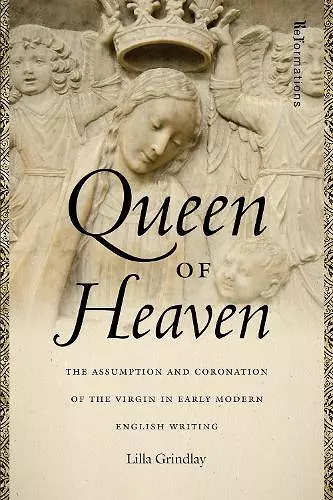Queen of Heaven
The Assumption and Coronation of the Virgin in Early Modern English Writing
Format:Hardback
Publisher:University of Notre Dame Press
Published:30th Sep '18
Currently unavailable, and unfortunately no date known when it will be back

The belief that the Virgin Mary was bodily assumed to be crowned as heaven’s Queen has been celebrated in the liturgy and literature of England since the fifth century. The upheaval of the Reformation brought radical changes in the beliefs surrounding the assumption and coronation, both of which were eliminated from state-approved liturgy.
Queen of Heaven examines canonical as well as obscure images of the Blessed Mother that present fresh evidence of the incompleteness of the English Reformation. Through an analysis of works by writers such as Edmund Spenser, Henry Constable, Sir John Harington, and the writers of the early modern rosary books, which were contraband during the Reformation, Grindlay finds that these images did not simply disappear during this time as lost “Catholic” symbols, but instead became sources of resistance and controversy, reflecting the anxieties triggered by the religious changes of the era.
Grindlay’s study of the Queen of Heaven affords an insight into England’s religious pluralism, revealing a porousness between medieval and early modern perspectives toward the Virgin and dispelling the notion that Catholic and Protestant attitudes on the subject were completely different. Grindlay reveals the extent to which the potent and treasured image of the Queen of Heaven was impossible to extinguish and remained of widespread cultural significance. Queen of Heaven will appeal to an academic audience, but its fresh, uncomplicated style will also engage intelligent, well-informed readers who have an interest in the Virgin Mary and in English Reformation history.
"Grindlay writes about an era that was going through a sort of adolescence, as new forms of power emerged in the body politic, in academia, and in the market place. In our own time, we face a similar sort of adolescence as the issues of communication, intelligence, and human identity confront us. This thoughtful study of the Virgin Mary reminds us that it is in beauty rather than function that the heavenly power and attraction of the Mother of Christ resides." —Church Times
"Despite being powerfully backed by a reigning monarch, the English Reformation also necessitated the dethronement of a reigning monarch. Dethroned monarchs never go quietly into the dark. Ever fainter echoes? Fading nostalgia? Secular disguise? A vanishing Virgin? Not so, argues Lilla Grindlay in this vigorous and rich book: Mary the Queen of Heaven stubbornly sticks around, taking many forms, some lurid, as she reclaims her throne." —James Simpson, Donald P. and Katherine B. Loker Professor of English, Harvard University
"The book makes an original contribution to the fields of gender studies and English religious and literary studies. Lilla Grindlay offers an important corrective to the long-standing claim that the Blessed Virgin Mary disappears from English religious writing at the dawn of the Protestant Reformation. The book is very well written. Grindlay's care for her subject is evident in every sentence. Ultimately, her goal is to persuade the reader that their understanding of the post-Reformation/post-medieval status of the Virgin is incomplete. The book is really lovely to read. Grindlay has taken great care to make her work accessible, interesting, and important."—Patricia Badir, author of The Maudlin Impression: English Literary Images of Mary Magdalene, 1550–1700
“This is a thoroughly stimulating volume, clearly written and helpfully sign-posted throughout that demonstrates Grindlay’s erudition as a literary scholar. It makes a helpful contribution to the field of English Reformation Studies and offers interesting insights for those studying gender in the early modern period.” —British Catholic History
“Grindlay’s book is timely and valuable, and remedies an important gap in Reformation studies by encouraging its readers to consider more nuanced accounts of cultural loss.” —Renaissance and Reformation
“Grindlay explains clearly and concisely why the (extra-scriptural) teachings that Mary was physically taken into heaven after her death and crowned queen of heaven created such a stark dividing line between Protestant and Catholic religious and literary culture.” —The Journal of Theological Studies
“The complex pattern of post-Reformation attitudes to Mary is examined in this intriguing book.” —The Living Church
ISBN: 9780268104092
Dimensions: 229mm x 152mm x 21mm
Weight: unknown
310 pages